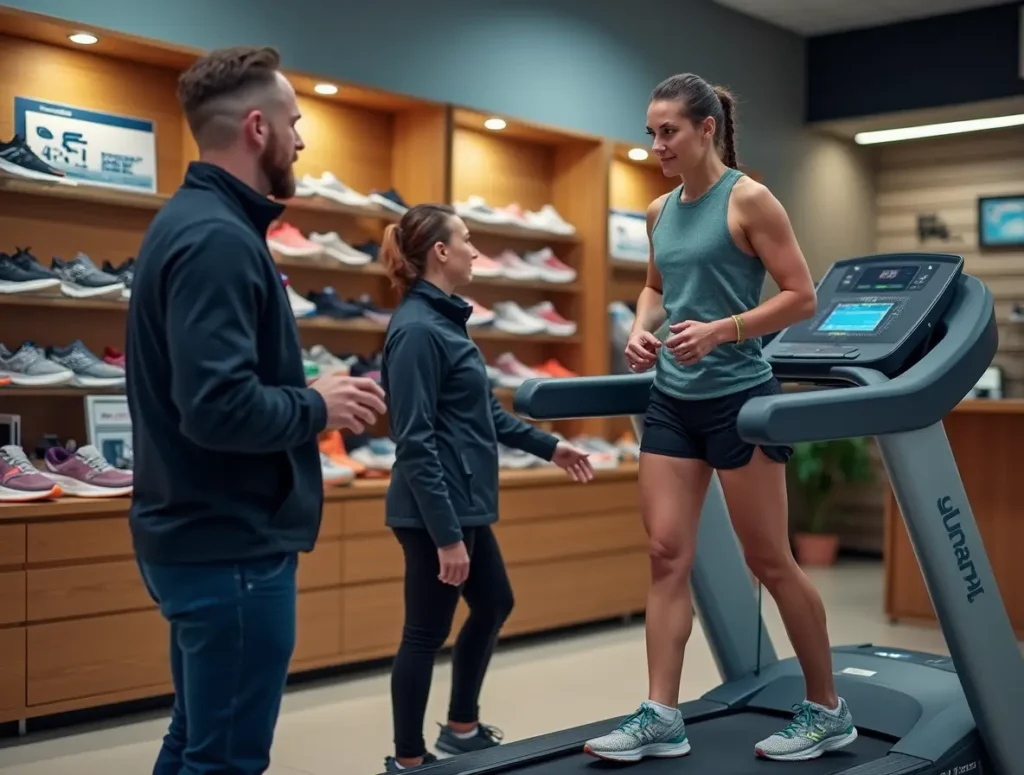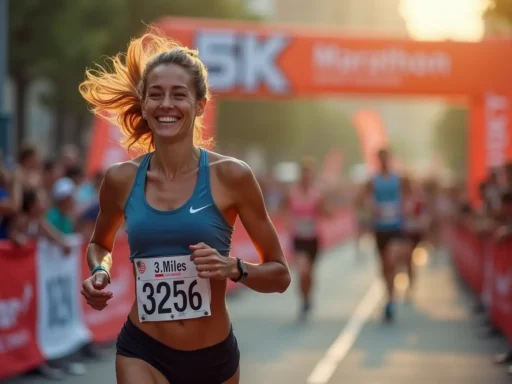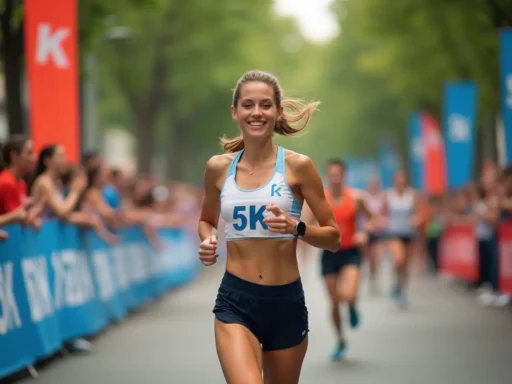Are you getting ready for a 5km race? You might wonder how many miles that is. Knowing the race distance is key to your training and getting ready. It helps you know what to expect and feel more confident.
Asking how many miles a 5km race is is a big step. It shows you’re ready to face the challenge. A 5km race is a big deal, needing good fitness and endurance. Knowing the distance helps you plan your training and get ready for the race.
Table of Contents
How Many Miles is a 5km Race: The Basic Conversion
To figure out the distance of a 5km race, you need to know its equivalent in miles. The conversion is straightforward: 1 kilometer equals 0.62 miles. So, a 5km race is roughly 3.1 miles. This is key, especially if you’re used to measuring in miles.

When training for a 5km race, knowing the conversion is vital. It helps you plan your route and track your progress. You can use online tools or a running app for this. For example, if you aim to run 3 miles, converting it to kilometers can help you understand the distance better.
Converting Kilometers to Miles
To convert kilometers to miles, use the formula: miles = kilometers * 0.62. This formula gives you an approximate value. For instance, to convert 5 kilometers to miles, multiply 5 by 0.62. This equals about 3.1 miles.
Why Races Use Kilometers
Races often use kilometers because it’s a common unit worldwide. It makes it easier for runners from different countries to compete and compare results. Plus, kilometers are simpler to mark on a race course, helping runners track their progress.
Understanding Race Distance Markers
Race distance markers are crucial for tracking progress during a race. These markers are set at regular intervals, like every kilometer or mile. Knowing these markers helps you pace yourself and stay focused on your goal. By understanding the distance of a 5km race, you can better prepare and make the most of your training.
Getting Started with 5km Race Training
Starting 5km race training needs a strong base. You should set achievable goals, plan your training, and learn the basics of running. As you start, focus on getting better at running longer and faster.
A good 5km race training plan mixes running, other exercises, and rest. It’s important to listen to your body, especially if you’re new to running. Here are a few tips to get you started:
- Begin with shorter runs and slowly build up your distance.
- Incorporate strength training to improve your overall running performance
- Make sure to stretch before and after each run to prevent injuries
5km race training is not just about physical work. It’s also about getting your mind ready. Stay motivated, and you’ll be ready to conquer your 5km race in no time.
| Week | Running Distance | Rest Days |
|---|---|---|
| 1 | 1km | 2 |
| 2 | 2km | 2 |
| 3 | 3km | 1 |
Building Your Base Fitness for a 5km
To win a 5km race, you need a solid base fitness. This means getting your heart rate up and improving your endurance. Start by doing activities that make your heart work harder.
Key parts of base fitness for a 5km include:
- Cardiovascular conditioning: This means doing exercises like running, cycling, or swimming to boost your heart’s efficiency.
- Strength training: Building strong core, legs, and glutes helps you run better and stay in good form.
- Flexibility and mobility work: Stretching and mobility exercises improve your movement and lower injury risk.
By working on these areas and getting more intense and longer, you’ll build a strong base fitness. Pay attention to your body and take rest when necessary. With hard work and dedication, you’ll be ready for a 5km race.
As you keep training, you’ll see better health and well-being. Your heart will get stronger, making daily tasks easier. With a solid base fitness, you’ll be ready for the 5km race and reach your goals.
Essential Gear for Your 5km Race
Getting ready for a 5km race means having the right gear. It’s important to pick running shoes that support and cushion your feet well. Proper fitting shoes can greatly improve your performance and comfort.
Choosing the right clothes is also key. Go for breathable and moisture-wicking fabrics to stay cool and dry. Don’t forget a good pair of socks to prevent blisters and discomfort.

Other must-haves include:
- Carry a water bottle or hydration pack to stay hydrated throughout the race.
- A running watch or fitness tracker to track your progress and pace
- Sunglasses and a hat are key to protect yourself from the sun. They help block harmful UV rays and prevent sunburn. Wearing them is essential for a safe and enjoyable day outdoors.
Having the right gear boosts your confidence and readiness for the race. Invest in quality shoes, comfy clothes, and accessories. This way, you can focus on your run and reach your goals.
Make sure your gear fits the race’s weather and terrain. With the right gear, you’ll run your best and enjoy the 5km race.
Creating Your 5km Training Schedule
Getting ready for a 5km race needs a solid training schedule. It should match your fitness and goals. Beginners should start with beginner training plans that slowly get harder and longer.
A good training schedule mixes running, cross-training, and rest. This mix prevents injuries, boosts fitness, and improves running. As you get better, add more challenging workouts like interval training and hill sprints.
Beginner Training Plans
- Begin with short runs (20-30 minutes) and gradually increase duration and frequency
- Include walk breaks to avoid burnout and prevent injuries
- Do strength training to boost running efficiency and lower injury risk
Intermediate and Advanced Training Plans
When you get more comfortable running, move to intermediate and advanced training schedule plans. These plans have tougher workouts, longer runs, and special training to help you reach your best.
| Training Plan | Duration | Frequency |
|---|---|---|
| Beginner | 20-30 minutes | 3 times a week |
| Intermediate | 30-45 minutes | 4 times a week |
| Advanced | 45-60 minutes | 5 times a week |
Proper Running Form and Technique
As you get ready for your 5km race, focusing on your running form and technique is key. Good running form makes you run better, lowers injury risk, and boosts performance. It’s all about your posture, foot strike, and breathing.
There are several important parts to running form. These include:
- Posture: Maintain an upright torso, relaxed shoulders, and keep your head up.
- Foot strike: Aim for a midfoot or forefoot strike, rather than heel striking
- Breathing: Practice deep, rhythmic breathing to help you stay relaxed and focused
By paying attention to these elements and practicing good technique, you can better your running form. Stay relaxed, listen to your body, and adjust as needed to keep good form and avoid injury.
With time and effort, you can build a strong, efficient running form. This will help you in your 5km race and future runs. Good technique combined with regular training and hard work will help you reach your running goals.
Nutrition Strategies for 5km Success
To succeed in a 5km race, good nutrition is key. You need to plan your meals, stay hydrated, and recover well after the race. This will help you perform at your best and meet your goals.
For a good pre-race meal, eat a balanced diet. Include complex carbs, lean protein, and healthy fats. This mix gives you the energy needed for the race. Try oatmeal with fruit and nuts, whole-grain toast with avocado and eggs, or grilled chicken with quinoa and veggies.
Key Nutrition Components
- Complex carbohydrates: brown rice, whole-grain bread, sweet potatoes
- Lean protein: chicken, fish, beans
- Healthy fats: nuts, seeds, avocado

Hydration is also crucial. Drink 8-10 glasses of water daily and avoid sugary drinks. Drink water or a sports drink 15-30 minutes before the race to stay hydrated.
Post-Run Recovery Nutrition
After the race, refuel with a balanced meal. Include protein and complex carbs to help your body recover. Try a smoothie bowl with banana, spinach, and almond milk, or grilled chicken with brown rice and steamed veggies.
By following these nutrition tips, you’ll perform well in your 5km race. This includes planning meals, staying hydrated, and recovering right after.
| Nutrition Component | Importance | Examples |
|---|---|---|
| Complex Carbohydrates | Provides energy | Brown rice, whole-grain bread, sweet potatoes |
| Lean Protein | Supports muscle function | Chicken, fish, beans |
| Healthy Fats | Supports overall health | Nuts, seeds, avocado |
Common 5km Race Mistakes to Avoid
As you get ready for your 5km race, knowing common mistakes is key. Starting too fast can lead to burnout. Start slow and pick up speed as you go.
Don’t forget to eat right and drink enough water. Proper nutrition and hydration boost your energy. They’re crucial for a good race.
Here are more mistakes to watch out for:
- Insufficient training, which can lead to injury or exhaustion
- Incorrect gear, such as wearing the wrong type of shoes or clothing
- Poor running form, which can cause discomfort and decrease your speed
Knowing these mistakes helps you avoid them. Stay focused, listen to your body, and make adjustments as needed to reach your goals.
With the right training, nutrition, and hydration, you can beat common mistakes. Stay committed, and you’ll have a great racing experience.
Pacing Strategies for Your 5km Race
Running a 5km race well means having a good pacing plan. It’s about finding the right balance between speed and endurance. Good pacing helps you stay strong and finish well.
To start, know your fitness level and set achievable goals. Plan your pace at the beginning, make changes in the middle, and end strong. Pacing strategies can boost your performance and success chances.
Understanding Starting Pace Guidelines
Finding the right starting pace is key for success in a 5km race. It should be challenging but not too hard, saving energy for later. Your starting pace depends on your fitness and goals. Start a bit slower than your target finish pace.
Mid-Race Adjustments and Finishing Strong
During the race, adjust your pace as needed. Speed up or slow down based on how you feel. Listen to your body and make changes to finish strong. With good pacing and focus, you can reach your goals and feel confident at the finish.
- Start with a conservative pace and gradually increase your speed as you warm up
- Use landmarks or mile markers to gauge your pace and make adjustments as needed
- Stay hydrated and fueled throughout the race to maintain your energy levels
Weather Considerations for Race Day
When you’re getting ready for your 5km race, think about the weather considerations that might affect you. Weather like heat, cold, and rain can change how comfortable and safe you feel on race day.
Here are some things to keep in mind:
- Temperature: Very hot or very cold weather can mess with your body’s temperature control. This might lead to heat exhaustion or hypothermia.
- Humidity: When it’s really humid, the air feels hotter and heavier. On the other hand, low humidity can cause dehydration.
- Precipitation: Rain or snow can make the course slippery. This increases the chance of getting hurt.
To get ready for different weather considerations, check the forecast before race day. Then, adjust your clothes and plan accordingly. You might need to wear layers, carry a rain jacket, or use special shoes for grip.
By thinking about weather considerations, you can make sure your race day is safe and successful.
| Weather Condition | Precautions |
|---|---|
| Heat | Stay hydrated, wear light clothes, and avoid running when it’s hottest |
| Cold | Wear layers, bring a hat and gloves, and stay dry |
| Rain | Wear a rain jacket, bring extra clothes, and use shoes with good grip |
Mental Preparation Techniques
As you get ready for Cromwell’s 5km race, remember that your mind is just as crucial as your body. Your mindset can really affect how well you do. Mental preparation techniques can help you stay sharp and driven. One great way to prepare is through visualization exercises, where you picture yourself finishing strong or getting past tough parts of the course.
Adding mental preparation to your training can boost your performance and cut down on race day stress. Here are some tips to get you started:
- Set specific, achievable goals for your race
- Practice visualization exercises to imagine yourself succeeding
- Develop a positive self-talk routine to stay motivated
Remember, mental preparation is essential for a winning race. By mixing physical training with visualization exercises and a positive attitude, you’ll be on your way to reaching your goals.
With regular practice and hard work, you can build the mental strength and resilience needed for the race. Stay focused, motivated, and committed to your goals. Then, you’ll be ready to face the 5km challenge with confidence.
Race Day Preparation Checklist
Getting ready for your 5km race is key. You need a race day preparation plan to stay focused. A good checklist is crucial for your success.
Here are important things to add to your checklist:
- Arrive early at the race venue to account for parking and registration
- Bring all necessary gear, including your running shoes, clothes, and hydration pack
- Plan your nutrition and hydration strategy, including what to eat and drink before and during the race
- Get familiar with the race course and weather conditions to prepare yourself mentally and physically
By following this checklist and staying focused, you’ll do great in your 5km race. Stay calm, have fun, and enjoy the race.
Understanding Race Timing and Tracking
As you get ready for your 5km race, knowing about race timing and tracking is key. Accurate timing helps measure your performance and how you’re improving. Chip timing basics are important, using a small chip or tag to track your time at different race points.
There are many ways to track your progress. Here are a few:
- Wear a GPS watch or fitness tracker to monitor your pace and distance
- Use a mobile app to track your route and time
- Take advantage of race timing services offered by the event organizers
By learning about chip timing basics and using these tracking methods, you can get insights into your performance. This helps you make changes to better your results. Remember, precise race timing is key to tracking your progress and reaching your goals.
Here’s a quick summary of important points for race timing and tracking:
| Method | Description |
|---|---|
| Chip Timing | Uses a small chip or tag to record time at various points |
| GPS Watch | Monitors pace and distance using GPS technology |
| Mobile App | Tracks route and time using a mobile device |
Recovery Tips After Your 5km Race
After finishing a 5km race, it’s crucial to focus on recovery tips. This helps your body heal and rebuild. A good recovery plan can greatly improve your performance and lower injury risks.
Stretching, foam rolling, and nutrition are key parts of a recovery plan. Stretching can lessen muscle soreness and boost flexibility. Foam rolling helps reduce muscle tension and improves blood flow. Eating a balanced diet with protein, complex carbs, and healthy fats helps refill energy and repair muscles.
Here are some more recovery tips for after your 5km race:
- Drink lots of water and electrolyte-rich drinks to stay hydrated
- Get enough sleep for your body to repair and rebuild
- Do light activities like walking or yoga to help blood flow and ease soreness
By following these recovery tips, you can help your body recover faster and lower injury risks. Always listen to your body and adjust your recovery plan as needed. This ensures you get the most from your training and performance.
| Recovery Tip | Benefits |
|---|---|
| Stretching | Reduces muscle soreness, improves flexibility |
| Foam Rolling | Reduces muscle tension, improves circulation |
| Proper Nutrition | Replenishes energy stores, supports muscle repair |
Conclusion: Embracing the 5km Challenge
The 5km race is an exciting challenge that can be rewarding and achievable. With the right preparation, you’ll feel proud and accomplished when you cross the finish line. Understanding the distance, having a solid training plan, and mastering race-day strategies are key.
At first, the 5km distance might seem daunting. But with dedication, consistency, and a positive mindset, you can conquer it. Celebrate your progress and enjoy the personal growth with each step. The 5km challenge is for everyone, whether you’re new to running or have experience.
So, get ready to run by lacing up your shoes and aiming for that 5km finish line. This journey will test your physical abilities and nourish your mind and spirit. Embrace the 5km challenge for a healthier, more fulfilling life.




